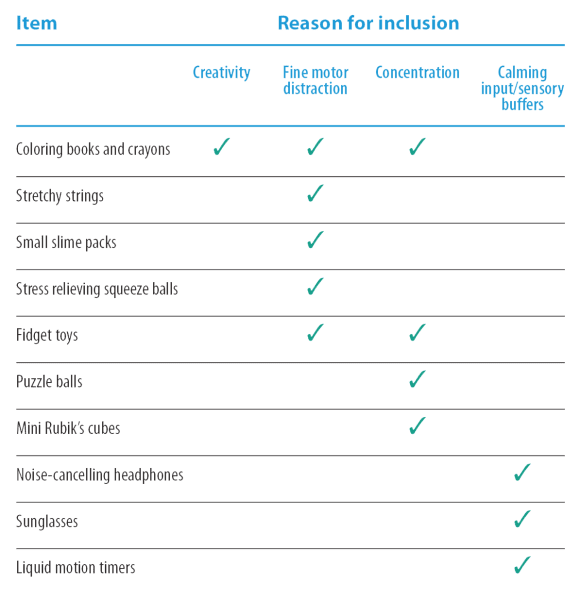Evidence-based strategies improve patient and family experiences.
- Over 5.4 million U.S. adults have received a diagnosis of autism spectrum disorder (ASD)
- Many clinical nurses don’t have the knowledge needed to customize patient-centered care to meet the individual needs of adults with ASD.
- Many organizations lack the resources to support clinical nurses in identifying adults with ASD and implementing appropriate care.
At our acute-care hospital, clinical nurses on the inpatient pediatric unit experience frequent requests for assistance in caring for adult patients with autism spectrum disorder (ASD). For example, a clinical nurse on an adult medical unit asked for help from a pediatric nurse when a 25-year-old patient with ASD wanted to sit on the floor and color. The nurse on the adult medical unit struggled to balance patient safety and the patient’s preference to sit on the floor, which they could have achieved by providing the patient with a mat for comfort and safety.
According to a 2020 study by Dietz and colleagues, over 5.4 million adults in the United States (2.21%) have received a diagnosis of ASD. However, autism services typically focus on children, which leaves adults with ASD vulnerable to healthcare disparities. Potential barriers to quality care for patients with ASD include a patient’s inability to effectively communicate their needs to providers, sensory issues worsened by the overstimulating hospital environment, and a lack of specialized ASD training among healthcare providers. Many pediatric units have strategies to ensure patient-centered care for children with ASD, which demonstrates that careful planning can minimize these barriers. However, a gap exists in the literature regarding the appropriate strategies for adult patients.
Interacting with individuals on the autism spectrum
Understanding pain in patients with intellectual disabilities
Nurses face two challenges when caring for adults with ASD: a lack of clinical knowledge regarding the customization of patient-centered care to meet the individual needs of these patients and a lack of organizational resources to support identifying and implementing that care. At our organization, an interprofessional team (a clinical nurse, nursing leaders, an occupational therapist, a social worker, a dietitian, a physician’s assistant from the hospitalist group, an advanced practice provider from the behavioral health intervention team, and a psychiatrist) developed an evidence-based practice (EBP) project aimed at creating holistic resources and education to address these challenges.
Evidence and translation
Using the Johns Hopkins Evidence-Based Practice Model and Tools, we searched for EBP recommendations. We summarized and synthesized six pieces of high- and good-quality evidence to generate the following evidence-based practice recommendations: engage family members and caregivers as key informants, implement comprehensive assessment tools, create a plan of care and communicate it, and provide autism education for nurses and other healthcare providers. (See EBP recommendations.)
EBP recommendations
The following evidence-based practice (EBP) recommendations support the care of adult patients with autism spectrum disorder (ASD).
- Use a comprehensive assessment tool as early as possible, ideally at admission, to identify patients with ASD.
- To learn about successful home strategies, engage caregivers as key informants in the patient assessment. Continue these strategies as feasible to reduce patient stress during procedures and hospitalization.
- Create a care plan based on the patient’s ASD assessment, communicate it to all care team members, and document it in the patient health record.
- Educate nurses and all other healthcare providers to ensure they have a basic understanding of ASD, have familiarity with intervention options, and can provide family-centered and patient-centered care.
Engage family members and caregivers
The project team implemented several comprehensive assessment tools to engage family members and caregivers to help develop individualized patient-centered care.
Admission history document.
The team added an option within the patient admission history to record the presence of an ASD diagnosis. Working with the information technology/clinical systems department, the team created a trigger from a positive response on this question, which then initiates consults for the behavioral health intervention team (BHIT), integrated case management, and the dietary department.
Behavioral health intervention team.
The BHIT includes nurses, physicians, and licensed mental health therapists who provide and guide the delivery of compassionate patient-centered care for those with behavioral and substance use issues, as well as support and consultation for clinical staff caring for them. Previously, the BHIT had been consulted only for patients with ASD with acting-out behaviors, but their expertise makes them an excellent fit as a foundational partner in advancing care for adults with ASD. Patients with ASD receive high priority for BHIT consultation, preceded only by patients who are a danger to themselves or others.
A BHIT member meets with the patient and family to complete the autism/developmental questionnaire (ADQ) and then collaborates with the patient’s clinical nurse and unit charge nurse to review it and the patient’s plan of care. Based on the ADQ responses, the BHIT member recommends items from the sensory toolkit and places the “Paws for Sensory Considerations” sign outside of the patient’s room. Follow-up BHIT visits occur based on the unique needs of the patient.
Autism/developmental questionnaire.
The EBP project team sought expert consultation from the University of South Florida’s Center for Autism and Related Disorders (CARD). Using best practice recommendations from CARD and the literature, the team developed a questionnaire that allows the patient and caregiver to communicate their unique needs to the healthcare team. After admission, BHIT staff use this questionnaire to assess and record patient preferences, abilities, interests, sensory issues, and effective coping strategies.
The ADQ is built into the organization’s electronic health record, which allows healthcare providers throughout the hospital to access the information. The completed ADQ is saved as a document, generating a customized interprofessional plan of care based on the responses, with key elements mirrored into a nursing shift summary. If the patient is ever re-admitted, the care team can retrieve and update the document as needed. (See Autism/developmental questionnaire.)
Autism/developmental questionnaire
To help adult patients with autism spectrum disorder have the best experience possible throughout hospitalization, the evidence-based practice project team developed the autism/developmental questionnaire (ADQ). Using the questionnaire, a member of the behavioral health intervention team collaborates with the family to understand patient needs, preferences, and coping strategies. The ADQ covers the following information:
- Abilities
- Behaviors/sensory issues/triggers (warning signs of dysregulation)
- Communication preferences and needs
- Daily life
- Dietary needs
- Pain
The ADQ concludes with assessment and behavioral comments.
Create and communicate plan of care
The EBP project team developed several strategies to guide the creation of the patient plan of care and then communicate it to all care team members.
ASD order set.
The project team created a new order set to guide nurses and other providers in strategies aimed at reducing patient sensory stimulation and overload. The order set includes consulting with occupational and speech therapy, using lidocaine cream for painful procedures (for example, during I.V. starts or lab draws), minimizing lab draws and vital signs as appropriate, using a private room with space for caregivers, and implementing injury prevention interventions for patient falls and seizures.
Nursing care plan.
The nursing care plan, which auto-populates in the patient’s chart, includes strategies for reducing stimulation (decreasing noise and light), speaking calmly and using short sentences when communicating with patients, and implementing the sensory toolkit. The team reviews the care plan at least once each shift and updates it as needed.
Integrated case management (ICM) consult.
The ICM team is consulted immediately upon admission to proactively assess for opportunities to aid with discharge planning. Evidence demonstrates that many patients with ASD experience an increased length of stay due largely to a lack of early discharge planning. This patient population may have behavioral or sensory needs that can’t be accommodated by some homes or facilities, so in the event the patient can’t return to their previous living arrangement, ICM can proactively start the process of finding an acceptable alternative.
Dietary consult.
Patients with ASD tend to have specific preferences, routines, and rituals around food and mealtimes. A dietary consult on admission can aid the development of a plan for nutritional support in collaboration with the patient and family and based on available hospital food options.
Sensory toolkit.
The EBP project team created the sensory toolkit using CARD recommendations to help patients self-regulate by managing their sensory needs and triggers. The toolkit is stored in the BHIT office and supplied and replenished by the BHIT clinical supervisor. Initial development of the sensory toolkit cost about $100; cost for upkeep and 6 months of supplies for 11 patients was $50. (See Sensory toolkit.)
“Paws for sensory considerations” sign. A sign posted with two animal paws (pun for the word “pause”) outside the patient’s door provides a subtle visual cue to remind healthcare team members of the patient’s heightened sensory status. The goal is to encourage staff to pause before entering and to speak to the patient’s nurse if they’re not already aware of the unique sensory needs of the patient.
Care team education
The project team designed and delivered three tiers of staff education—foundational, clinical, and advanced—based on expected level of patient interaction. The foundational tier offers all employees a brief overview of ASD with optimal strategies for patient-centered care. The more detailed clinical tier, delivered via live webinar and recorded for use as a continued resource, targets all inpatient, procedural, behavioral, and BHIT clinicians. This tier includes details about ASD diagnosis, presentation, treatment options, and goals of care; care strategies for ASD-related behavioral exacerbations; and an overview of organization-specific clinical processes for caring for patients with ASD. The advanced tier, which targets BHIT and members of behaviorally focused units, provides additional advanced care strategies for behavioral management.
The EBP project team is integrating this education into nursing orientation materials and organization-level annual employee education. The team’s future plans include developing discipline-specific education and resources for ancillary departments that interact with patients, such as phlebotomy, dietary, and radiology. In addition, the team is creating an intranet resource page, accessible by all employees, to support just-in-time reference needs.
Bridge the practice gap
At the beginning of the project, nurses and other care team members had no means for identifying patients with ASD, so no baseline data existed. However, the project team plans to now measure both process and quality outcomes. Measurement of process outcomes includes assessments of staff satisfaction and education, efficiency of organizational resources and practices, and adherence to procedures and documentation. Quality outcomes include patient and family experience, workplace violence, and length of stay. The team anticipates that improved understanding of patient-centered care will reduce patient triggers and staff mismanagement of acting-out behaviors, which may lead to fewer episodes of patient and staff injury. Improved proactive assessment and management of patient needs also may lead to reductions in patient length of stay.
We encourage nurses, other healthcare clinicians, and leaders to bridge the practice gap that exists for hospitalized adults with ASD. For access to or discussion about specific resources, please email the lead author at Shannon-Mersinger@smh.com
The authors work at Sarasota Memorial Hospital in Sarasota, Florida. Shannon Mersinger is a pediatric intervention nurse, Jennifer I. Bonamer, is a nursing professional development and research specialist, Chris Donnelly is a nursing professional development specialist, David Stone is clinical supervisor of the behavioral health intervention team, and Corinne Brown is the Magnet® program director.
American Nurse Journal. 2024; 19(6). Doi: 10.51256/ANJ062440
References
Ailey SH, Johnson TJ, Cabrera A. Evaluation of factors related to prolonged lengths of stay for patients with autism with or without intellectual disability. J Psychosoc Nurs Ment Health Serv. 2019;57(7):17-22. doi:10.3928/02793695-20190205-01
Broder-Fingert S, Shui A, Ferrone C, et al. A pilot study of autism-specific care plans during hospital admission. Pediatrics. 2016;137(Suppl 2):S196-204. doi:10.1542/peds.2015-2851R
Carter J, Broder-Fingert S, Neumeyer A, Giauque A, Kao A, Iyasere C. Brief report: Meeting the needs of medically hospitalized adults with autism: A provider and patient toolkit. J Autism Dev Disord. 2017;47(5):1510-29. doi:10.1007/s10803-017-3040-5
Center for Autism Related Disabilities. University of South Florida. bit.ly/3W3aHFM
Centers for Medicare & Medicaid Services. HCAHPS: Patients’ perspectives of care survey. cms.gov/Medicare/Quality-Initiatives-Patient-Assessment-Instruments/HospitalQualityInits/HospitalHCAHPS.
Dang D, Dearholt SL, Bissett K, Ascenzi J, Whalen M. Johns Hopkins Evidence-Based Practice for Nurses and Healthcare Professionals: Model and Guidelines. 4th ed. Indianapolis, IN: Sigma Theta Tau International; 2021.
Dietz PM, Rose CE, McArthur D, Maenner M. National and state estimates of adults with autism spectrum disorder. J Autism Dev Disord. 2020;50(12):4258-66. doi:10.1007/s10803-020-04494-4
Gerber AH, McCormick CE, Levine TP, Morrow EM, Anders TF, Sheinkopf SJ. Brief report: Factors influencing healthcare satisfaction in adults with autism spectrum disorder. J Autism Dev Disord. 2017;47(6):1896-1903. doi:10.1007/s10803-017-3087-3
Nathenson RA, Zablotsky B. The transition to the adult health care system among youths with autism spectrum disorder. Psychiatr Serv. 2017;68(7):735-8. doi:10.1176/appi.ps.201600239
National Autistic Society. Patients on the autism spectrum: Guidance for health professionals. Authored: September 20, 2017; retrieved: June 23, 2019. https://www.autism.org.uk/advice-and-guidance
Quiban C, Brooks R, Armstrong D. Caring for adult patients with autism in the critical care setting. Crit Care Nurs Q. 2020;43(1):58-67. doi:10.1097/CNQ.0000000000000291
Key words: autism, autism spectrum disorder, adult autism



















